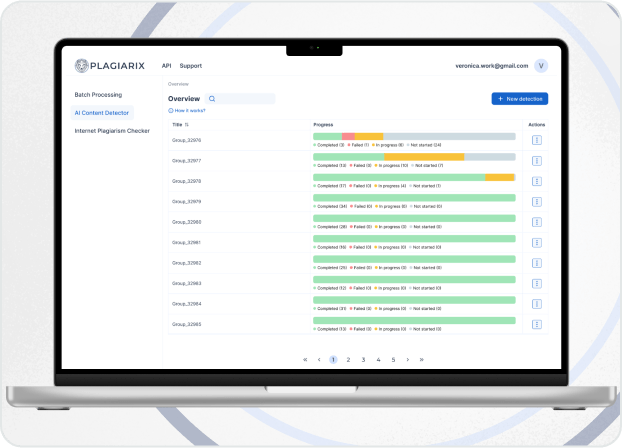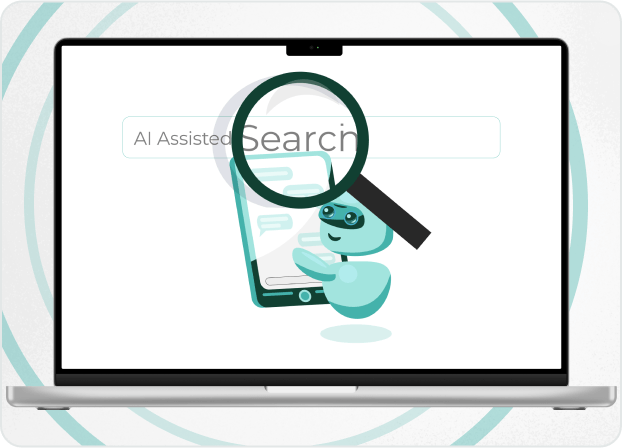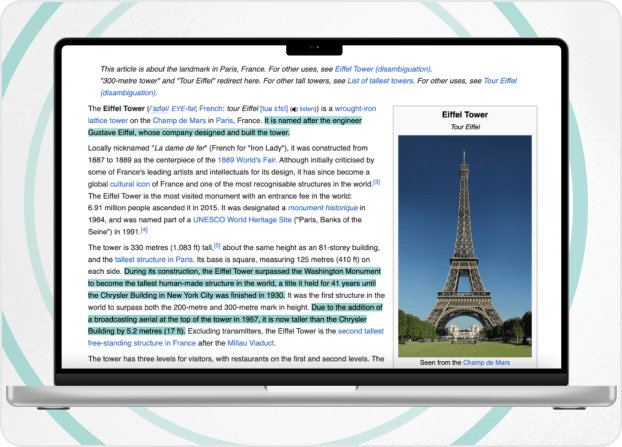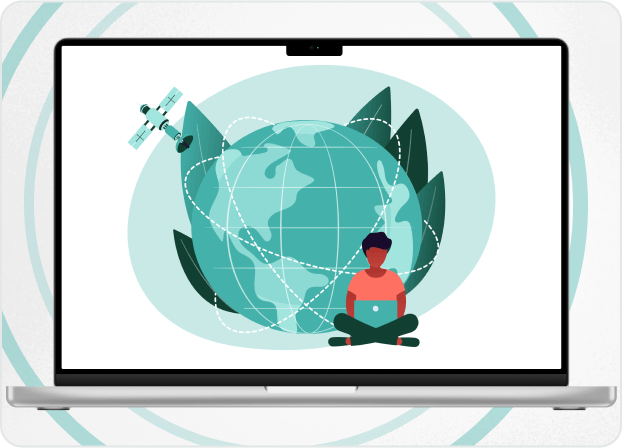
Expert’s Thoughts

"AI adoption has got through unprecedented boost in the past years, but the pricing behind most AI projects remains inconsistent, complex but rapidly evolving. As a result, businesses who wish to invest in AI development or get their own AI tool just don’t know what the costs are expected.
Silk Data prepared this overview on key factors defining AI software prices to help businesses figure out the pricing policies of the AI developers."
Yuri Svirid, PhD. — CEO Silk Data
Key Insights of the Industry
First, let’s have a look at some important insights from the industry of AI development and business implementation of AI tools.
Comprehensive Artificial Intelligence Index Report created by Stanford University at the very beginning of 2025 indicates the following statistics on the AI development market and business needs for AI solutions.
There are more than 2 000 new AI companies founded in the world in 2024, and 10% of them focus on the generative AI direction.
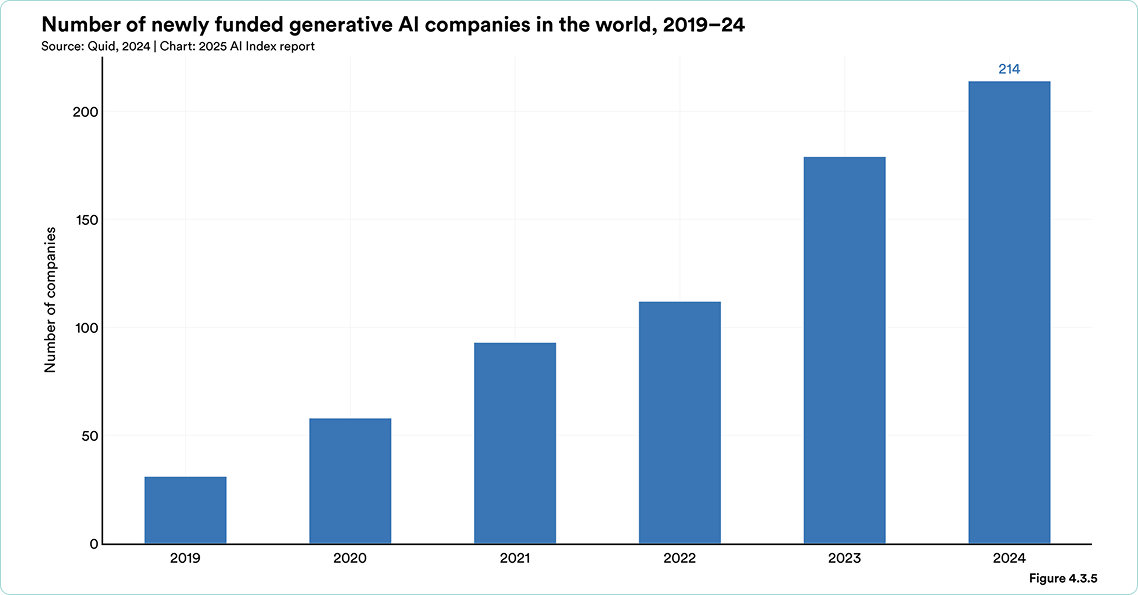
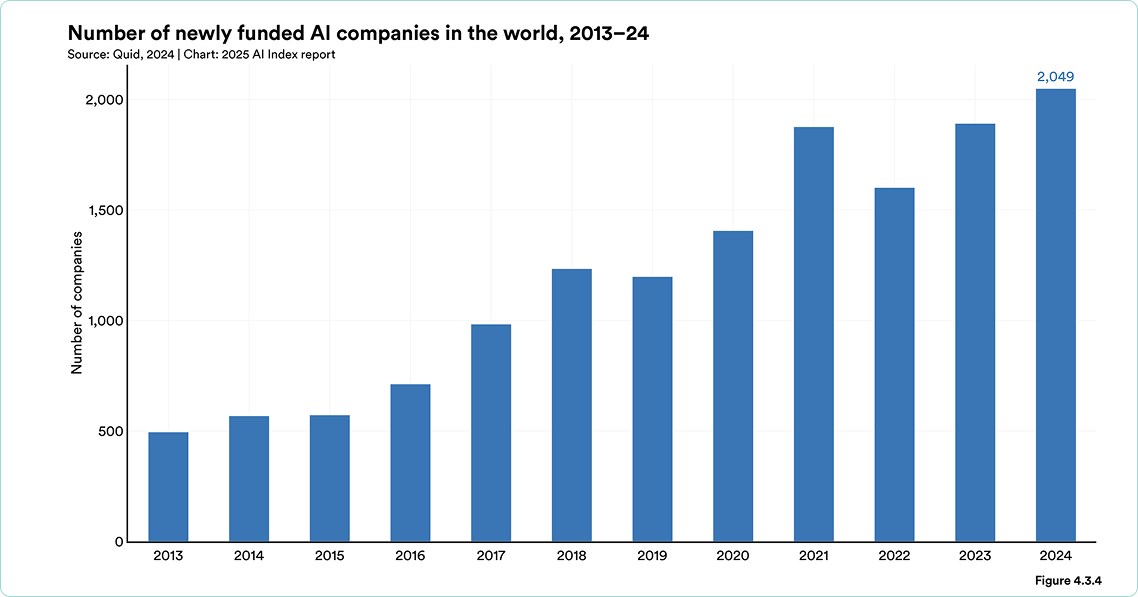
Source: https://hai-production.s3.amazonaws.com/files/hai_ai_index_report_2025.pdf
Most investments in 2024 were received by companies focusing on AI infrastructure, research and governance (37.3 billion USD), i.e. companies specifically building AI applications.
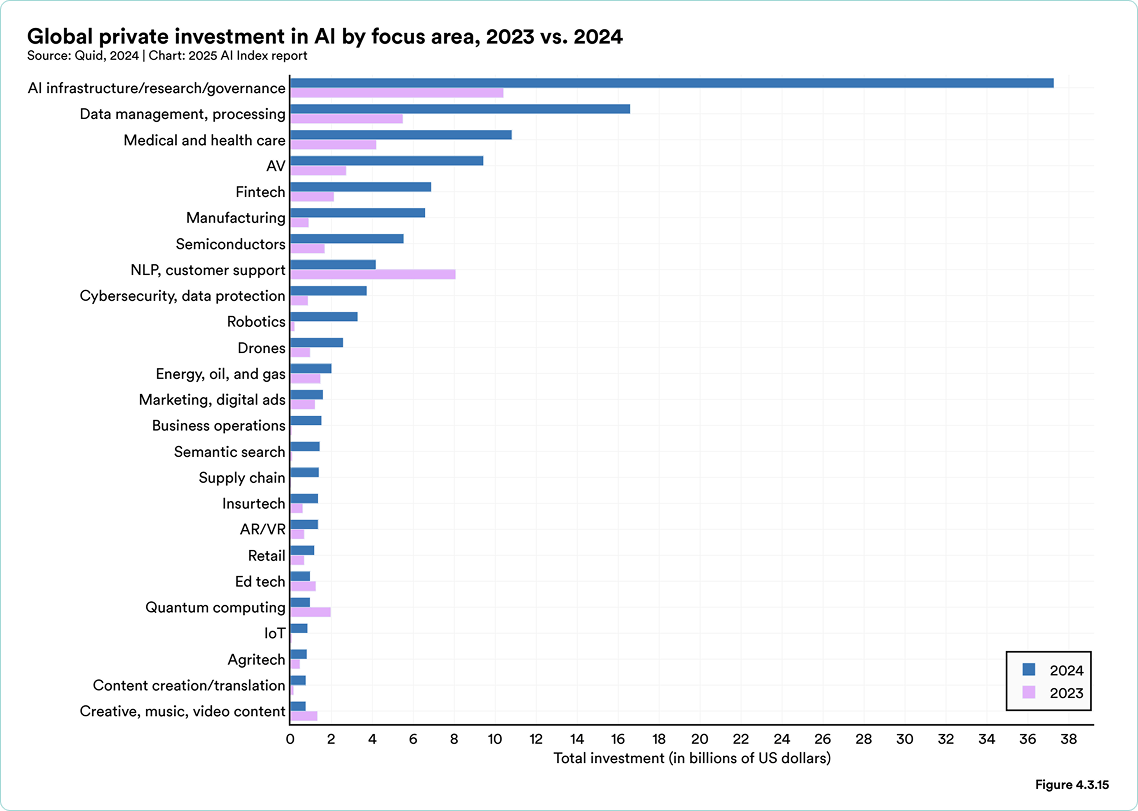
Source: https://hai-production.s3.amazonaws.com/files/hai_ai_index_report_2025.pdf
Two main fields of AI implementation are analytics and content generation.
From the point of analytics, AI tools provide sufficient aid in both the company’s cost savings and revenue gains.
The most prominent results in cost savings through AI implementation were demonstrated in areas of service operations, supply chain, management and software engineering.
At the same time, 71% of respondents indicate that AI tools appear to be the most useful in marketing and sales, providing the highest value from the point of revenue gains.
The main tasks that can be solved are:
- Marketing strategy content generation (data gathering, idea generation, drafting, etc.).
- Generation of personalized content.
- Automation of sales interactions.
- Code generation (natural language to code translation, tests development, debugging).
- Providing real-time suggestions for customer support.
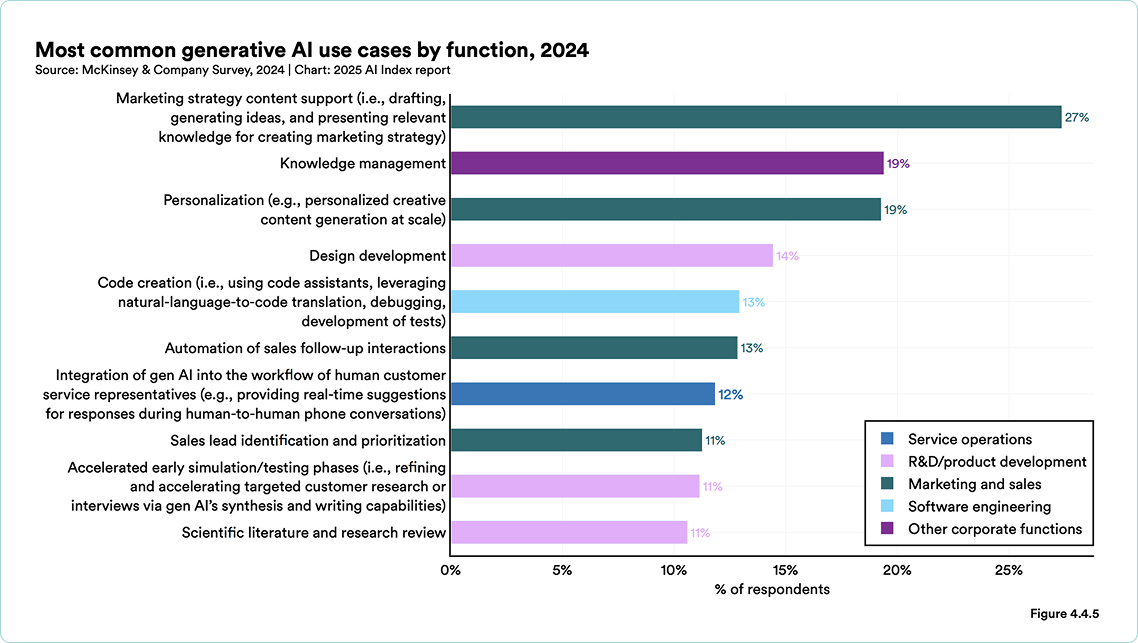
Source: https://hai-production.s3.amazonaws.com/files/hai_ai_index_report_2025.pdf
Though the advantages given by AI implementation are unquestionable, the costs of such an implementation and the amount of money that needs to be spent on AI development projects remain unclear.
Note. Our purpose here is not to provide you with exact numbers and create a misconception of how much AI costs. We want to show that there’re lots of factors that define the final price, and there’s no ‘ideal project’ where the vast range of features can be developed with minimal costs.
Main Factors Defining AI Software Prices
Based on the years of dealing with AI projects of various functional specifications, scale and complexity, we can highlight five key criteria that dramatically affect the cost of artificial intelligence solutions.

Project scope and complexity
The first thing that you must define is how massive a desirable solution is.
For example, you need a simple chatbot that will solve primitive communication or searching tasks (like chatbots used on some social media or in customer service). These solutions typically base on a fixed set of rules (so-called ‘rule-based’ chatbots with ‘if-then logic’) or strict conversational pathways (scripted chatbots).
These chatbots are not AI tools in modern understanding, as they have no reasoning or learning capabilities, they don’t comprehend the context and follow rather primitive logic.
Therefore, a rule-based chatbot solution will hardly cost more than a few thousand dollars and its development and implementation will take mere weeks.
At the same time, you can seek a more complicated AI tool based on the work of large language models.
LLM-based tools are good at contextual understanding of requests along with semantic analysis of tests and queries. For example, Silk Data developed procurement software that allows to process customer requests, extracting the keywords and analyzing the intention of the message. In the end, the request is automatically transferred to a specialist needed with an AI-appointed status.
The result of the software’s implementation was the fact that the procurement company could automate workflows regarding customer requests’ processing, improve retail and supply management practices and implement real-time analytics that allows to get the freshest data on user queries.
If you look for the same solution (or solution of the same complexity and similar functionality), you should understand that its development may take months, and the advanced technologies used along with the greater number of specialists required mean that the development and implementation costs can easily exceed 50 000 USD.
One more factor that defines the final costs is the way you get access to LLM capabilities. You can ask for custom LLM development, which is more expensive at the first stages, but provides you full control over app’s or software’s functions. At the same time, you can ask for implementation of the popular LLM API , for example, ChatGPT. It is typically quicker and cheaper, but the costs can intensively increase because of the pricing policies of the API’s provider.
Before going further, we need to clarify that the two above-mentioned solutions represent the technology of natural language processing . Nevertheless, each solution focuses on the problems of different complexities demonstrating different working approaches, though each of them is created to percept and process natural human language.
However, this type of solution is far from being the most expensive and sophisticated. Some businesses may look for truly advanced AI solutions for enterprise needs, requiring smooth automated work with large data amounts and enhanced predictive analytics capabilities.
Such a solution can be implemented via AI agent development and deployment. AI agents are advanced artificial intelligence tools aimed at solving complicated tasks with minimal human intervention. These tools obtain advanced capabilities of real-time data analysis, reasoning, self-learning and self-correction, making them extremely useful for medium and large enterprises.
At the same time, AI agents’ outstanding features imply greater costs of development. For example, Cleo AI, being a prominent example of an application based on an AI agent’s capabilities. It’s an AI financial assistant that helps individuals understand their spending habits, optimize budgets and improve their financial literacy through financial data processing, AI-driven insights and predictive analytics. According to some estimates, the project could cost the company at least 150 000 USD with the highest estimations of 500 000 USD.
One more specific type of AI solution is the one based on computer vision technology.
Projects oriented on computer vision put the ability to perceive, process and analyze graphical and video content at the first place. In doing so, computer vision can work with real-time analysis (for example, permanently tracking the movement of real objects) or pre-recorded content processing (for example, photos or video records).
In addition, computer vision projects can also differ by complexity, scale and the variety and amount of hardware needed (special cameras, sensors, etc.). Through that, all the cost numbers are only estimates, though even small project rates may start from dozens of thousands of dollars.
The summarized comparison of different projects is presented on the following table.
| Criteria | Rule-based or scripted solution | LLM-based solution | AI agent | Computer vision |
|---|---|---|---|---|
| Scope | Simple Q&A, predefined tasks | Contextual understanding, intent analysis | Autonomous decision-making, predictive analytics | Facial and emotion recognition, objects tracking |
| Complexity | Low (based on sets of fixed rules) | Medium (semantic analysis) | High (self-learning, real-time data processing) | Medium/High (depends on the project needs and specifics) |
| Learning capabilities | None | Limited (typically work within the frames of the implemented LLM) | Advanced (self-improvement via new data) | Depend on the project requirements, in most cases limited |
| Context understanding | No | Yes | Advanced | Vary from minimal to high, influencing the speed and costs of development |
| Development time | Weeks | 3-9 months | 6 months – year+ | From weeks to months (depending on the solution requirements) |
| Development costs | 5 000 $ on average | 50 000 – 100 000 $ (depends on whether you choose API implementation or custom LLM development) | 150 000 – 500 000+ $ | 30 000 – 100 000 $ |
| Possible use cases | FAQ bots, basic customer service | Procurement automation, customer request routing, prompt-based content generation, smart recommendations | Smart assistance, enterprise analytics, strategic decision-making | Mobile devices facial recognition, software for self-driving cars, surveillance systems |

Data availability and quality
Next factor that inflicts AI software prices is the condition of data used while AI solution development.
In many cases working with data of any type (market insights statistics, CMS monitoring data, user requests examples, etc.) takes a lot of time of the development team and the spent resources estimations are typically mentioned in project specification or vendor’s invoices (if you choose true professionals able to highlight the project stages and expected costs).
The resources spent on working with data as well as the final project price directly depend on how structured your data is along with its availability. It's clear that unstructured data requires longer periods of processing, while limited availability (for example, when the business needs any extended data) means more time spent on research and data gathering.
Altogether these factors lead the potential AI project to a higher cost.
For instance, the software’s functionality in one of Silk Data’s projects fully depended on the quality of the initial data.
Our team developed an AI-based solution for a large agricultural company. The main task was to build a system of predictive analysis and automated monitoring for the health condition of livestock.
No small part of the project was dedicated to gathering data regarding the health conditions of thousands of cows for the last 6 and 12 months. This data had become the basis for a testing dataset used in further AI model training.
Furthermore, during the features engineering process our specialists came across a certain amount of erroneous data that contained false information. Through that, additional data cleaning steps were added, and we provided a set of recommendations for company specialists on how to avoid it in the future.

Development approach
When you get to the option of outsourced AI development, you must know that different outsourcing approaches imply both different costs of solution creation and its delivery.
We have thoroughly overviewed the key differences between outsourcing models , so we’ll just barely touch each of them in the following comparative table.
| Criteria | Onshore | Offshore | Nearshore |
|---|---|---|---|
| Hiring costs | Highest (follow the market tendencies of your country or city) | Lowest (up to 200% cost reduction) | Medium (still can be high for large scale projects) |
| Talent pool | Limited | Wide | Medium |
| Speed of result’s delivery | High (thanks to similar time zones, cultural, legal and communication ethics) | Low (because of the different legal and working policies) | Medium (still can be problems with taxation and legal issues) |
Still, there’s no absolutely right choice in the question of which approach is better. The best option depends on the business’s needs, whether it’ speed of result delivery, cost efficiency or ease of cooperation. From the point of money, nearshoring seems to be the most preferable, as it combines affordable prices with relatively smooth workflows.

Project specifics
Do you want to get a cloud-based AI solution or that working on local processing and maintenance (on-premise)? Perhaps, you require the product of high scalability or limited requests handling will be enough? Do you need any task-oriented functionality, developed especially for the industries of healthcare, finances, public services or legal? Answering all these questions can be summarized in one term - ‘project specification’.
For example, you need a solution that provides no upfront hardware costs, based on an AI model permanently managed by a provider that will demonstrate vast scalability capabilities. Then, you can apply to the solution that implies implementation of popular LLM’s API (for example, ChatGPT). This solution has a certain number of advantages and disadvantages for business, which were highlighted in our comprehensive overview of how ChatGPT changed the AI landscape .
At the same time, any range of tasks specific for the industry may require additional time (for example, specifically fine-tuning an AI model), which inevitably leads to additional costs.
For instance, you are a bank looking for an AI-based solution that will deal with customer requests for loans and will help automate the processing of such requests. Through that, you need a tool that can extract information even from printed or scanned documents, find the key information (also classifying the documents according to the content contained) and provide smart recommendations on further decision-making, like Silk Data’s AI-based document analysis software.
Adding such functionality still requires additional work for AI specialists, and any task-specific project should be thoroughly discussed at the very beginning of the planned cooperation. As a result, the project costs can increase, and the medium point can range between 50 000 to 120 000 USD and more.

AI team rates
One of the most obvious criteria that defines the price of AI projects is the experience of AI specialists and present tendencies of their native outsourcing and hiring markets.
The experience directly inflicts the expertise of participating in various AI projects, familiarity with technological stacks, tools and development approaches, while market tendencies highlight the rates the AI specialists tend to work for.
The following table presents the AI developers hiring costs gathered and summarized by Index.dev agency in February 2025.
| Region | Junior Level | Middle Level | Senior Level | Architect/Team Lead |
|---|---|---|---|---|
| Central and Eastern Europe | 45-70 $/hour | 70-120 $/hour | 120-160 $/hour | 160-200 $/hour |
| Latin America | 40-70 $/ hour | 70-110 $ /hour | 110-160 $/hour | 160-180 $/hour |
| Asia | 30-60 $/hour | 60-100 $/hour | 100-160 $/hour | 160-220 $/hour |
| Western Europe | 80-110 $/hour | 110-150 $/hour | 150-200 $/hour | 200-250 $/hour |
| North America | 80-120 $/hour | 120-150$/hour | 150-220 $/hour | 220-300 $/hour |

Post-launch operations
Finally, you should consider the necessity of regular monitoring and updating your solution which, if applied, also leads to additional costs. Post-launch operations are especially critical for AI-based mobile applications that always must align with the new versions of mobile operational systems.
In other cases, monitoring and updating can be crucial, as all AI models, even the most perpetrated demonstrate hallucinations and performance downfalls, when exposed to new, real-world data. For example, a customer service chatbot trained on historical queries may struggle with emerging slang or industry trends, requiring periodic fine-tuning to maintain accuracy.
A few words about PoC and MVP
One more point that we have to discuss is technical and business approvement of future AI solutions. Their necessity can hardly be overestimated, as it’s always better to test your business ideas before getting to real development. Here’s where Proof of Concept and Minimum Viable Product development join the game.
PoC is a small-scale test project specially designed to validate the feasibility, practicality and potential value of an idea or possible solution. For that purpose, the PoC projects always have very clear success criteria which serve as the basis for further decisions on whether to carry on the project or not.
The project simplicity implies that PoC hardly takes more than a few weeks to develop and typically ranges from 5 to 20 thousand dollars.
At the same time, MVP is considered a more complicated solution, which is also used to validate product idea, but from another point of view.
In essence, MVP is a first functional version of the software, program or application used to demonstrate whether it can solve problems and perform operations it was designed for. It is still not a fully operational solution, but its value lies in understanding of the products practical capabilities.
Talking about AI MVP projects, we should understand that the final cost (as well as in any other AI-related project) is a combination of time and resources spent on data preparation, infrastructure development, minimal UX/UI integration and security compliance. However, approximate estimations demonstrate that standard MVP projects can take 2-5 months and 35 000 – 55 000 dollars (though, the most large-scale multifunctional AI MVPs can exceed 100 000).
Even though both PoC and MVP are not full-scale AI projects, their value can’t be overestimated. The results of these projects show the relevance, compatibility and functional capabilities of AI-based solutions. This is one of the foundations for the further decision-making process.
Conclusion
AI adoption is permanently transforming industries, but its pricing remains a field of many variables - scope, data quality, deployment models and post-launch demands - all shape the final cost.
The key takeaway is that AI isn’t universally expensive, but it is contextually priced. A 5 000-dollar chatbot and a 500 000-dollar AI agent both solve problems, but at different scales and with different specifications. Your project’s ideal cost is a combination of business ambitions and realistic resources.
Still can’t figure out what to choose and where to develop? Try our IT consulting services and talk to our experts for a tailored assessment!
Our Solutions
We work in various directions, providing a vast range of IT and AI services. Moreover, working on any task, we’re able to provide you with products of different complexity and elaboration, including proof of concept, minimum viable product, or full product development.


















